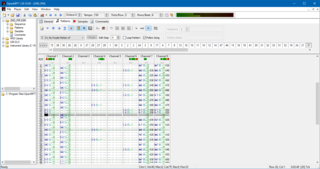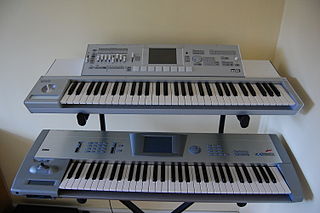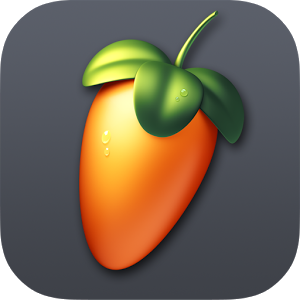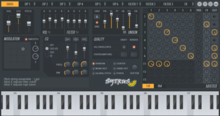
A digital synthesizer is a synthesizer that uses digital signal processing (DSP) techniques to make musical sounds. This in contrast to older analog synthesizers, which produce music using analog electronics, and samplers, which play back digital recordings of acoustic, electric, or electronic instruments. Some digital synthesizers emulate analog synthesizers; others include sampling capability in addition to digital synthesis.

Digital music technology encompasses digital instruments, computers, electronic effects units, software, or digital audio equipment by a performer, composer, sound engineer, DJ, or record producer to produce, perform or record music. The term refers to electronic devices, instruments, computer hardware, and software used in performance, playback, recording, composition, mixing, analysis, and editing of music.
A music sequencer is a device or application software that can record, edit, or play back music, by handling note and performance information in several forms, typically CV/Gate, MIDI, or Open Sound Control (OSC), and possibly audio and automation data for digital audio workstations (DAWs) and plug-ins.
A software synthesizer or softsynth is a computer program that generates digital audio, usually for music. Computer software that can create sounds or music is not new, but advances in processing speed now allow softsynths to accomplish the same tasks that previously required the dedicated hardware of a conventional synthesizer. Softsynths may be readily interfaced with other music software such as music sequencers typically in the context of a digital audio workstation. Softsynths are usually less expensive and can be more portable than dedicated hardware.

A music tracker is a type of music sequencer software for creating music. The music is represented as discrete musical notes positioned in several channels at chronological positions on a vertical timeline. A music tracker's user interface is traditionally number based. Notes, parameter changes, effects and other commands are entered with the keyboard into a grid of fixed time slots as codes consisting of letters, numbers and hexadecimal digits. Separate patterns have independent timelines; a complete song consists of a master list of repeated patterns.
Wavetable synthesis is a sound synthesis technique used to create quasi-periodic waveforms often used in the production of musical tones or notes.
A music workstation is an electronic musical instrument providing the facilities of:

FL Studio is a digital audio workstation (DAW) developed by the Belgian company Image-Line. It features a graphical user interface with a pattern-based music sequencer. The program is available in four different editions for Microsoft Windows and macOS.

Virtual Studio Technology (VST) is an audio plug-in software interface that integrates software synthesizers and effects units into digital audio workstations. VST and similar technologies use digital signal processing to simulate traditional recording studio hardware in software. Thousands of plugins exist, both commercial and freeware, and many audio applications support VST under license from its creator, Steinberg.

A digital audio workstation (DAW) is an electronic device or application software used for recording, editing and producing audio files. DAWs come in a wide variety of configurations from a single software program on a laptop, to an integrated stand-alone unit, all the way to a highly complex configuration of numerous components controlled by a central computer. Regardless of configuration, modern DAWs have a central interface that allows the user to alter and mix multiple recordings and tracks into a final produced piece.

The Korg Triton is a music workstation synthesizer, featuring digital sampling and sequencing, released in 1999. It uses Korg's HI Synthesis tone generator and was eventually available in several model variants with numerous upgrade options. The Triton became renowned as a benchmark of keyboard technology, and has been widely featured in music videos and live concerts. At the NAMM 2007, Korg announced the Korg M3 as its successor.

The Korg Wavestation is a vector synthesis synthesizer first produced in the early 1990s and later re-released as a software synthesizer in 2004. Its primary innovation was Wave Sequencing, a method of multi-timbral sound generation in which different PCM waveform data are played successively, resulting in continuously evolving sounds. The Wavestation's "Advanced Vector Synthesis" sound architecture resembled early vector synths such as the Sequential Circuits Prophet VS.

Image-Line Software is a Belgian software company best known for its digital audio workstation program FL Studio and related audio plugins such as Sytrus and Harmor. Image-Line was founded in 1994. In 2007, Image-Line introduced Deckadance, a virtual DJ console application. The company also produced EZGenerator, a template-based web editing program.

Deckadance is a DJ console and mixing tool developed by Image-Line software and acquired in 2015 by Gibson. Initially released in May 2007, it operates on Windows and Mac OS X, and comes in a House Edition and Club Edition. The latter has support for timecoded vinyl.

A synthesizer is an electronic musical instrument that generates audio signals. Synthesizers typically create sounds by generating waveforms through methods including subtractive synthesis, additive synthesis and frequency modulation synthesis. These sounds may be altered by components such as filters, which cut or boost frequencies; envelopes, which control articulation, or how notes begin and end; and low-frequency oscillators, which modulate parameters such as pitch, volume, or filter characteristics affecting timbre. Synthesizers are typically played with keyboards or controlled by sequencers, software or other instruments and may be synchronized to other equipment via MIDI.

FL Studio Mobile is a digital audio workstation available for Android, iOS and Windows UWP.

Magnus Choir is a commercial, proprietary music software synthesizer, for the Microsoft Windows and macOS operating systems, written by Daniel Laiseca and developed by Syntheway Virtual Musical Instruments. The first version was released in 2005.

Harmor is a software synthesizer created by Image-Line Software for the music production program FL Studio. It is available as a demo version within the software; however, it must be purchased separately in order to save projects that contain Harmor instances. Harmor is an upgraded and more elaborate version of its predecessor, Harmless. It was originally released with a 32-bit engine, and upgraded to a 64-bit engine in 2013.
Maschine is a hardware/software digital audio workstation developed by Native Instruments. Maschine consists of a controller that connects to the included sequencing software, which can be installed on any compatible computer or laptop.












